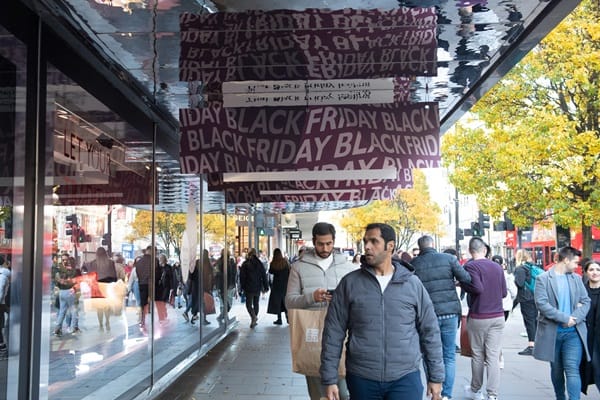The retail landscape is undergoing a transformation, and whilst it may be the end for some, as has proved the case for the likes of Wilko and The Body Shop, it may be the start of a new dawn for others smart enough to evolve and change.
There is also cause for optimism on the horizon: according to the ONS, retail sales rebounded by 3.4% in January, the largest growth in monthly sales in almost 3 years.
Here in the capital, Hammerson, saw footfall into leading shopping centres, rise by 3% last year, according to its latest results. Opening up retail in London is also on the Government’s agenda, with the Treasury mulling bringing back tax-free shopping, which would provide a huge boost to the capital.
There are two truths that should guide London businesses’ thinking as they try to seize this market momentum. Firstly, they must confront the truth that some products and services are best delivered via remote business or digital stores, and it will be a struggle to retain them in the real world.
On the flipside, other products and services either cannot be delivered remotely, or are best delivered in person and these are the areas that retailers and landlords need to focus on: hair and nails, fitness, restaurants, jewellery and high-end fashion.
So, what are the top trends London’s retail players need to plug into if they are to reinvigorate the capital’s shopping scene?
- Convergence of physical and digital retail
The lines between physical and digital retail are blurring. Successful retailers will need to seamlessly integrate online and offline experiences through initiatives such as click-and-collect services, augmented reality (AR) in-store experiences, and personalisation based on online behaviour and AI analysis.
- Social commerce
Social media platforms such as Facebook are becoming shopping destinations. It is where the younger generations ‘hang out’ and we will see more shoppable posts, influencer collaborations, and user-generated content with direct to-home transactions. One way retailers can deal with this is by entering the market themselves, pushing their products via social media in an educational way, and offering both retail and ecommerce purchase options.
- Experiential retail
Successful retailers and shopping centres should focus on creating memorable experiences such as pop-up shops; interactive displays; and kiosks and workshops on new foods or personal styling. Look at the impact that Outernet, an immersive display on Tottenham Court Road, has had on footfall to the local shops. According to Savills’ latest research, footfall on this eastern end of Oxford Street is up 19% year-on-year, thanks to the successful mix of experiential retail, new office developments and the Elizabeth line.
More festivals, exhibitions, and live performances are the way forwards. Many shopping centres are also anchoring customers’ experiences around cinemas and quality dining choices to create the ‘perfect day and evening out’.
- AR-powered shopping experiences
Another driver of change will be the use of augmented reality in-store to enhance the buying experience for some categories, such as furniture, decorating products, fashion and even hairstyling. Expect more virtual try-ons, AR catalogues, and in-store navigation.
Brands like Nike have been ahead of the curve on AR; for instance, their Inside Track interactive experience at Westfield allows customers to compare footwear. However, this may be a fleeting movement, as it might not be long before consumers can get the same experience at home with their own personal AR headsets.
- Data-driven retail
The smart retailers are already using data from loyalty schemes to analyse their shoppers and understand or predict behaviour. Such data is used for stock control, staffing rosters, discount pricing and even hours of opening. But there is a limit to how many loyalty schemes consumers want to be in, so many will fail. Robust alternatives include heat maps, exit surveys, facial recognition and prize promotions.
- Values-driven retail
Retail brands will need to up their game and compete on values, emphasising sustainability and social responsibility. It may be unfair, but few seem to worry about the ‘Green miles’ of The HUT Group delivering your £5 lipstick, however consumers will increasingly want to know that their local shops have LED lights, minimal packaging, waste recycling, ethical sourcing and strong community engagement.
There is also an opportunity for brands to be savvy about the wider social impact of initiatives to boost footfall. For instance, recently Hammerson brought the Charity Super.Mkt, the UK’s first shop space bringing multiple charities under one roof, to Brent Cross.
- Why Pay Now?
Flexible payment options attract younger consumers especially with the recent high interest rates. An increase in the promotion of Buy Now, Pay Later schemes is anticipated to ease the cost of purchasing large value items, but also loyalty programmes and subscription services are expected for lower value items such as hairdressing, meal delivery and even clothing rental.
- I want it now
Efficient logistics are crucial for customer satisfaction. There is nothing worse than trekking to Oxford Street on a Saturday and braving the crowds only to find your item is out of stock in your size or colour. Brands need to focus on improved logistics with full stocking of range, the option of same-day delivery using micro-fulfilment centres and last-mile delivery innovations (which is commonly considered the most challenging and costly part of the delivery process). Robot delivery vehicles are now a common sight in Milton Keynes, but their impact in bigger cities like London remains to be seen.
- I want it right
There is growing dissatisfaction with the quality of many goods bought online. Return rates for fashion can be as high as 40% due to issues with sizing and fabric and fit. Retailers should focus on the fact that they can offer a ‘get it right, first time’ service in-store because you are able to try on your new clothes, see the real colour of that new toaster or walk in the new shoes, all without the risk, inconvenience and cost of sorting returns for unsatisfactory online purchases.
In this new dawn for London’s retail industry, adaptability, creativity, and a customer-centric approach will be key. Those that embrace innovation and community engagement will at least thrive in the short term, as the landscape evolves around them. The signs are that retail has turned a corner, but we’re not out of the woods just yet.






Leave a Comment